Auto Accident
Auto Accidents & Personal Injury Cases
We specialize in treating patients who have been injured in motor vehicle accidents, providing personalized care to help reduce pain, restore function, and support long-term healing. Whether you're dealing with whiplash, back pain, or joint stiffness, our experienced team uses gentle, effective techniques tailored to your specific injuries. From your initial consultation through your recovery plan, we focus on helping you feel better, move better, and get back to living your life with confidence.

Treatment of Auto Accident Injuries may help the body...
Faster Recovery
Prompt chiropractic care can reduce inflammation, relieve pain, and speed up the healing process.
Prevent Long-Term Damage
Early treatment helps prevent chronic pain, mobility issues, and long-term spinal complications.
Stronger Legal Documentation
Professional medical records support your personal injury case and improve your chances of fair compensation.
Comprehensive Care and Legal Support After an Auto Accident
At MVMT Matters, we specialize in treating a wide range of injuries resulting from auto accidents and personal injuries, including whiplash, herniated discs, joint dysfunction, and soft tissue trauma. Our experienced chiropractors take a personalized approach to each case, understanding that no two injuries—or recoveries—are the same. We’re committed to helping you alleviate pain, regain mobility, and restore overall wellness through customized treatment plans designed to address both immediate symptoms and long-term recovery. By partnering with trusted medical professionals including orthopedists, neurologists, MRI centers, and physical therapists, we ensure our patients receive the most comprehensive care possible following an auto accident. Whether you’re facing acute injuries or ongoing discomfort, we’re here to support your journey to healing with compassionate and professional care.
Navigating a personal injury case can be overwhelming, especially when you’re trying to manage both your recovery and the stress of dealing with insurance companies. At MVMT Matters, we work closely with some of the top personal injury law firms to ensure you receive the strong legal representation you deserve. Our goal is to make the med-legal process as smooth and stress-free as possible, so you can focus on healing while we help coordinate your care and support your case every step of the way. MVMT Matters proudly serves patients at our convenient locations in Sacramento and Folsom.
ZERO Out of Pocket Expense For Auto Accident Patients
What Conditions Will Benefit?
Chiropractic treatment offers targeted relief and supports natural healing for a wide range of auto accident injuries.
-
-
- Whiplash
- Herniated or bulging discs
- Neck and back pain
- Muscle strains and sprains
- Joint pain and dysfunction
- Concussions and post-concussive symptoms
- Headaches and migraines
- Nerve compression or pinched nerves
-
- Soft tissue injuries
- Reduced range of motion
- Shoulder, knee, and hip pain
- Sciatica
- Dizziness and vertigo
- Muscle stiffness and spasms
- Chronic pain development prevention
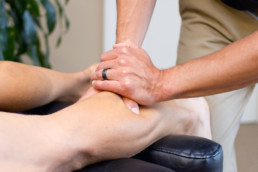
Learn More About Auto Accidents & Personal Injuries
What to Expect During Treatment
When beginning care for auto accident-related injuries, a thorough evaluation is conducted to develop a personalized treatment plan tailored to your specific needs. In many cases, diagnostic imaging is recommended to better understand the extent of trauma and guide effective care. You can expect gentle, focused treatments designed to reduce pain, improve mobility, and support the body’s natural healing process. Detailed documentation of your injuries and progress is also maintained to assist with your personal injury case. Throughout your recovery, your chiropractor will collaborate closely with attorneys and other healthcare providers to ensure you receive complete and coordinated care from start to finish.
The initial evaluation is approximately one hour in duration, with follow-up treatment sessions typically lasting between 15 and 30 minutes.
How Many Treatments Are Recommended?
The number of chiropractic treatments needed following a auto accident varies based on the severity of the injuries and the individual’s response to care. Most treatment plans range from a few weeks to several months, with progress regularly evaluated to ensure optimal recovery.
Core Values
Mission
At MVMT Matters, our mission is to provide top-quality care to athletes and weekend warriors by utilizing a comprehensive, holistic approach to treatment that helps active individuals recover from injuries and improve their overall health and wellbeing. We strive to empower our patients with the knowledge and tools they need to take an active role in their own healthcare.
Vision
At MVMT Matters, our vision is to be at the forefront of sports rehabilitation and preventative healthcare by setting new standards of excellence through exceptional care and remarkable experiences. We want to inspire people to reach their physical potential and help them lead active, healthy, and fulfilling lives.
Hyperbaric Oxygen Therapy may help the body...
Patient-centered care
We prioritize the needs and goals of our patients and are committed to providing comprehensive treatment plans that are based on their unique needs and goals. We are dedicated to implementing the highest quality care that places patients and their families at the center of our practice.
Empowerment
We advocate for healthcare that gives people control of their own health and wellness. We empower our patients to take an active role in their recovery through education, communication, advocacy, and collaboration.
Integrity
We are steadfast in our adherence to the highest professional, moral, and ethical standards, always acting in the best interests of our patients. We focus on delivering consistent results and communicating progress clearly.
Innovation
We are constantly seeking new and cutting edge interventions to improve our treatment methods and work to stay future-focused and committed to bringing new advancements in healthcare that generate differentiated value for everyone.
Evidence-based practice
We utilize the latest research and evidence-based practices to guide our treatment decisions and ensure optimal outcomes for our patients. We work hard to design proven programs that facilitate healing and recovery.
Teamwork
Collaboration is at the heart of our approach to healthcare, and we work closely with other specialists, coaches, and professionals to provide comprehensive and coordinated care that meets the unique needs of each patient.

Myofascial Cupping
Myofascial Cupping
From Olympic athletes to pregnant pop-stars, people are rediscovering the benefits of this ancient treatment. Myofascial Cupping is one of the oldest forms of medical treatment available today. Originating in Eastern China and Africa, this method of treatment is chosen to relieve pain and tension in the body using negative pressure to gently lift the skin of cups.
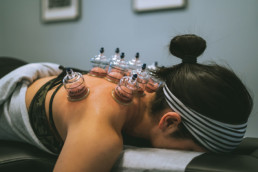
Active Release Techniques may help the body...
Improve Function
Relaxes muscular tension, improves range of motion, desensitizes nerves and soft tissue structures.
Reduce Inflammation
Improves localized circulation, reduces inflammation, and aids in lympathatic drainage.
Drug-Free Pain Relief
Decreases pain intensity and pain perception quickly and effectively.
What is Myofascial Cupping?
Myofascial cupping is a soft tissue modality that uses negative pressure to gently lift the skin and underlying connective tissue. When cups are applied to the skin, the tissue is drawn up into the cup. This decompression increases localized circulation, relaxes soft tissues, and is thought to stimulate healing.
Dynamic cupping follows a similar process, but rather than leaving the cup on one area of the skin, the therapist glides cups along the tissue with a similar intent to IASTM / Graston Technique. In addition, both static and dynamic methods can incorporate active movement to address faulty movement patterns and improve myofascial tissue glide.
Chinese cupping dates back to 28AD.
Physiologic Benefits
Increase Range of Motion
Research shows that ART treatments can help improve range of motion and mobility in those with musculoskeletal disorders or following injuries (acute trauma) and episodes of chronic pain.
One study published in the Journal of Physical Therapy Science demonstrated significant changes in range of motion compared to the control group. The ART group was found to produce greater improvements overall in several of the markers compared to the control group.
Pain Relief
Several studies demonstrate that Active Release Techniques can reduce pain intensity and pain pressure thresholds post treatment.
One study conducted by the Korean Academy of Physical Therapy Rehabilitation Science found that ART helps lower symptoms of lower back pain, considered to be one of the leading sources of dysfunction among adults.
Reduces Nerve Entrapments
A study published in the Journal of Chiropractic Medicine suggest that Active Release Techniques can be an effective treatment strategy for patients with carpal tunnel syndrome, which results in limited hand mobility and often swelling or pain due to nerve compression. Following treatment, patients reported significant improvements in symptom severity and showed increases in functional status scores compared to the start of the study.
Mitochondrial Support
HBOT allows mitochondria, the batteries of our cells, to generate adenosine triphosphate, or ATP. ATP is the chemical that stores and releases energy necessary for many cellular processes and is the main energy source for our body. When you have experienced cellular damage and oxygen-carrying capacity is threatened, your body is in jeopardy of not creating enough ATP. By providing high levels of oxygen, HBOT helps optimize cellular energy production.
Neovascularization
Hyperbaric oxygen therapy stimulates the growth of new blood vessels in the body, which increases circulation, allowing revitalized tissue to thrive even after the treatment protocol has been completed.
Stem Cell Mobilization
During treatment, HBOT has the power to increase stem cells in circulation eight-fold. These stems cells already exist in the body and have the unique ability to differentiate into any type of tissue, making them a valuable tool for regeneration and healing.
What Conditions Will Benefit?
ART treatment is effective against signs and symptoms of muscle and nerve dysfunction – sometimes referred to as soft-tissue conditions or MSDs – including tightness, pain, tingling, inflammation, restricted range of motion, muscle ache, and related symptoms.
- Arthritis
- Sports Injuries
- Neck Pain (Cervical Sprain / Strain)
- Back Pain (Lumbar Sprain / Strain)
- Knee Pain (Patellofemoral Disorders)
- Ankle Pain (Achilles Tendinitis)
- Foot Pain (Plantar Fasciitis)
- Shoulder Pain (Rotator Cuff Tendinitis)
- Tennis Elbow (Lateral Epicondylitis)
- Golfer’s Elbow (Medial Epicondylitis)
- Wrist Pain (Carpal Tunnel Syndrome)
- IT Band (Iliotibial Band)
- Repetitive Stress Injuries
- Muscle Strains
- Ligament Sprains
- Shin Splints

Learn More About Myofascial Cupping
What to Expect During Treatment
Treatment sessions last about 15-minutes and many patients experience dramatic reduction in pain and increase in range of motion after their first treatment.
How Many Treatments Are Recommended?
How many sessions a person needs depends on the severity of the health concern. While many people may benefit from a single session, often times more complex conditions may require more frequent treatment.
Chiropractic
Chiropractic Care
One of the most researched conservative techniques shown to be very effective at restoring proper motion in joints throughout the body. Healthy joint motion is imperative to maintaining quality movement throughout the entire body and reduce the stress and risk of injuries in the spine and extremities.
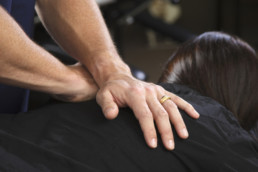
Active Release Techniques may help the body...
Improve Motion & Function
Restores proper joint motion and function that may compromise neural integrity and your general health.
Drug-Free Pain Relief
Decreases inflammation, and pain intensity quickly and effectively.
Improve Posture
Correct joint and soft tissue structures that may be leading to poor posture, and pain.
What is Chiropractic?
Chiropractic care offers a conservative, non-invasive approach to managing musculoskeletal pain and enhancing overall function—an option chosen by millions of Americans seeking relief without the use of drugs or surgery.
The spine, made up of 24 articulating vertebrae, plays a critical role in supporting movement, posture, and protecting the central nervous system. Since the nervous system governs nearly every bodily function, maintaining spinal health is essential for optimal physical performance and well-being.
When joints in the spine become restricted or misaligned—a condition commonly referred to in chiropractic care as joint dysfunction or subluxation—it can interfere with normal movement patterns and nervous system communication. This dysfunction may lead to pain, stiffness, reduced mobility, and in some cases, contribute to issues in other parts of the body due to altered biomechanics or nervous system signaling.
Importantly, symptoms such as back or neck pain are often late indicators of an underlying issue. Many spinal dysfunctions can develop gradually and remain asymptomatic for extended periods. This is why proactive and consistent chiropractic care can be beneficial—not just for symptom relief, but as part of a strategy to maintain joint function, support proper movement patterns, and support long-term health and activity levels.
A natural, drug-free approach to healthcare.
Physiologic Benefits
Increase Range of Motion
Research shows that ART treatments can help improve range of motion and mobility in those with musculoskeletal disorders or following injuries (acute trauma) and episodes of chronic pain.
One study published in the Journal of Physical Therapy Science demonstrated significant changes in range of motion compared to the control group. The ART group was found to produce greater improvements overall in several of the markers compared to the control group.
Pain Relief
Several studies demonstrate that Active Release Techniques can reduce pain intensity and pain pressure thresholds post treatment.
One study conducted by the Korean Academy of Physical Therapy Rehabilitation Science found that ART helps lower symptoms of lower back pain, considered to be one of the leading sources of dysfunction among adults.
Reduces Nerve Entrapments
A study published in the Journal of Chiropractic Medicine suggest that Active Release Techniques can be an effective treatment strategy for patients with carpal tunnel syndrome, which results in limited hand mobility and often swelling or pain due to nerve compression. Following treatment, patients reported significant improvements in symptom severity and showed increases in functional status scores compared to the start of the study.
Mitochondrial Support
HBOT allows mitochondria, the batteries of our cells, to generate adenosine triphosphate, or ATP. ATP is the chemical that stores and releases energy necessary for many cellular processes and is the main energy source for our body. When you have experienced cellular damage and oxygen-carrying capacity is threatened, your body is in jeopardy of not creating enough ATP. By providing high levels of oxygen, HBOT helps optimize cellular energy production.
Neovascularization
Hyperbaric oxygen therapy stimulates the growth of new blood vessels in the body, which increases circulation, allowing revitalized tissue to thrive even after the treatment protocol has been completed.
Stem Cell Mobilization
During treatment, HBOT has the power to increase stem cells in circulation eight-fold. These stems cells already exist in the body and have the unique ability to differentiate into any type of tissue, making them a valuable tool for regeneration and healing.
What Conditions Will Benefit?
Chiropractic is more than just a solution for back pain, it’s key to a healthy lifestyle.
- Arthritis
- Sports Injuries
- Neck Pain (Cervical Sprain / Strain)
- Back Pain (Lumbar Sprain / Strain)
- Knee Pain (Patellofemoral Disorders)
- Ankle Pain
- Foot Pain (Plantar Fasciitis)
- Shoulder Pain
- Elbow Pain
- Wrist Pain (Carpal Tunnel Syndrome)
- IT Band (Iliotibial Band Syndrome)
- Degenerative Disc Disease
- Degenerative Joint Disease
- Disc Injuries
- Spinal Stenosis
- Pinched Nerves (Radiculopathy)
- Sciatica
- Repetitive Stress Injuries
- TMJ
- Muscle Strains
- Ligament Sprains
- Shin Splints

Learn More About Chiropractic
What to Expect During Treatment
Treatments are typically under 15-minutes and many patients experience dramatic reduction in pain and increase in range of motion after their first treatment.
How Many Treatments Are Recommended?
How many sessions a person needs depends on the severity of the health concern. While many people may benefit from a single session, often times more complex conditions may require more frequent treatment.
Movement Prescription
Movement Prescription
Active care is essential to sustainable progress. Our comprehensive program is designed to correct dysfunctional movement patterns, restore range of motion, and strengthen the affected structures in a safe and effective manner. Movement based dysfunctions require movement based solutions. We offer individualized movement prescription, delivered on our mobile app platform to guide your recovery.

Hyperbaric Oxygen Therapy may help the body...
Improve Mobility
Develop Motor Control
Build Strength & Resiliency
What is Deep Tissue Laser Therapy?
Laser therapy is a medical treatment that uses focused light to stimulate a process called photobiomodulation (PBM). During PBM, photons enter the tissue and trigger a biological cascade of events that leads to an increase in cellular metabolism, which can decrease pain and inflammation and accelerate the healing process. Laser therapy is used to treat acute and chronic conditions as well as post-activity recovery. When treating acute conditions with laser therapy, it is particularly effective when it is administered as soon as possible following injury. With chronic conditions, laser therapy is used most often to help combat persistent pain and inflammation. To aid in post-activity recovery, LightForce Lasers are used by over 250 pro, college, and Olympic sports teams across the United States and many parts of Europe and East Asia.

Individualized Exercise Programming delivered on our mobile app!
Physiologic Benefits
Accelerated Tissue Repair And Cell Growth
Accelerate cellular reproduction and growth. Unlike other treatment modalities, powerful Class 4 Laser Therapy can penetrate superficial tissues and deliver healing energy to deeper structures and articular surfaces. Cells of cartilage, bone, tendons, ligaments and muscles are repaired faster as a result of exposure to high powered NIR or Near InfraRed Laser photons.
Reduced Fibrous Tissue Formation
Class 4 Laser therapy reduces the formation of scar tissue following tissue damage and acute and chronic inflammatory processes. This point is paramount because fibrous (scar) tissue is less elastic, has poorer circulation, is more pain sensitive, weaker, and much more prone to re-injury and frequent exacerbation.
Anti-Inflammation
Laser light therapy has an anti-inflammatory effect, as it causes vasodilation and activation of the lymphatic drainage system. As a result, there is a reduction in swelling caused by biomechanical stress, trauma, overuse, or systemic conditions. Being able to easy support the movement of lymph support faster healing.
Analgesia
Laser therapy has a multifaceted beneficial effect on pain relief. It activates production of high levels of pain killing chemicals such as endorphins and enkephalins from the brain and adrenal gland. Additionally it initiates the suppression of nerve signal transmission over unmyelinated c-fibers that transmit pain to the brain. This means that a greater amount of stimuli is required to create an action potential within the nerve to signal pain.
Improved Vascular Activity
Laser light will significantly increase the formation of new capillaries (angiogenesis) in damaged tissue that will speed up the healing process. Additionally, it has been noted in the literature that microcirculation increases secondary to vasodilation during laser treatment.
Stimulates Trigger Points and Acupuncture Points
Stimulates muscle trigger points to help release contracted tissues, helps restoration of muscular tonus and balance. Can also be used to quickly and easily treat acupoints and trace meridians to quickly open up blocked energy flow within numerous body systems from the macro to the micro-systems.
What Conditions Will Benefit?
Deep Tissue Laser Therapy has been clinically proven as an effective treatment for a vast array of both acute and chronic conditions.
- Arthritis
- Sports Injuries
- Neck Pain (Cervical Sprain / Strain)
- Back Pain (Lumbar Sprain / Strain)
- Knee Pain (Patellofemoral Disorders)
- Ankle Pain (Achilles Tendinitis)
- Foot Pain (Plantar Fasciitis)
- Shoulder Pain (Rotator Cuff Tendinitis)
- Tennis Elbow (Lateral Epicondylitis)
- Golfer’s Elbow (Medial Epicondylitis)
- Wrist Pain (Carpal Tunnel Syndrome)
- IT Band (Iliotibial Band)
- Repetitive Stress Injuries
- TMJ
- Muscle Strains
- Ligament Sprains
- Shin Splints
- Rheumatoid Arthritis
- Herpes Zoster (Shingles)
- Diabetic Neuropathy
- Diabetic Foot Ulcers
- Trigeminal Neuralgia
- Burns
- Deep Edema / Congestion

Learn More About Deep Tissue Laser Therapy
What to Expect During Treatment
Laser therapy treatments must be administered directly to skin, as laser light cannot penetrate through layers of clothing. You will feel a soothing warmth as the therapy is administered. Many patients receiving LightForce® Therapy Laser treatments report enjoying the experience, especially when a massage-ball treatment head is used to deliver what is often referred to as a “laser massage.”
Patients receiving treatments with higher-power lasers also frequently report a rapid decrease in pain. For someone suffering from chronic pain, this effect can be particularly pronounced. Laser therapy for pain can be a viable treatment.
With LightForce® lasers, treatments are quick usually 3-10 minutes depending on the size, depth, and acuteness of the condition being treated. High-power lasers are able to deliver a lot of energy in a small amount of time, allowing therapeutic dosages to be achieved quickly. For patients and clinicians with packed schedules, fast and effective treatments are a must.
How Many Treatments Are Recommended?
How many treatments a person needs depends on the severity of the health condition. While many people may benefit from a single session, often times more complex conditions may require more frequent treatment. Most clinicians will encourage their patients to receive 2-3 treatments per week as the therapy is initiated. There is a well-documented support that the benefits of laser therapy are cumulative, suggesting that plans for incorporating laser as part of a patient’s plan of care should involve early, frequent treatments that may be administered less frequently as the symptoms resolve. Your doctor will develop a treatment plan that is optimal for your condition.
Shockwave Therapy
Shockwave Therapy
Shockwave Therapy is an evidence-based treatment that gets to the root of your pain, facilitating healing and accelerating your recovery. Shockwave improves your body’s regenerative potential, rather than further damaging an area that has degenerated because of poor blood flow, tissue injury, overuse or weakness. Offering Shockwave Therapy in Sacramento and Folsom.
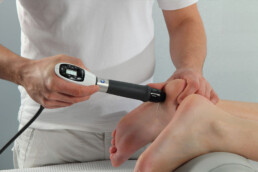
Active Release Techniques may help the body...
Accelerate Healing
Stimulates soft tissue & bone repair, nerve regeneration, & increased cellular metabolism.
Drug-Free Pain Relief
Decreases pain intensity and pain pressure thresholds quickly and effectively.
Restore Function
Improves range of motion, release tissue adhesions, calcifications and helps correct soft tissue dysfunction.
What is Shockwave Therapy?
Shockwave Therapy, also referred to as radial pressure wave (EPAT) and focused shockwave (ESWT) is today’s most innovative approach to treating acute and chronic musculoskeletal pain and connective tissue disorders. It’s backed by evidence and works in tandem with a range of other regenerative solutions for exceptional outcomes. This proprietary technology is based on a unique set of pressure waves that stimulate the metabolism, enhance blood circulation and accelerate the healing process. Damaged tissue gradually regenerates and eventually heals. This non-invasive clinic based procedure represents a breakthrough treatment option for a broad range of musculoskeletal conditions.
Shockwave has virtually no risks or side effects. In some cases, patients may experience some minor discomfort which may continue for a few days. It is normal to have some residual pain after intense exercise or a full day of work. We are proud to offer both groundbreaking technologies, Extracorporeal Pulse Activation Technology (EPAT) and Extracorporeal Shock Wave Therapy (ESWT).
The single most effective treatment for tendiopathy.
Physiologic Benefits
Accelerated Healing
Stem Cells have a high therapeutic potential and are therefore used in various areas of regenerative medicine. Several studies have found that radial shockwaves significantly promoted the proliferation and self-renewal of mesenchymal stem cells in vitro and safely accelerated the cartilage repair and proliferation of cells in bone, tendon, cartilage, nerve and connective tissue, indicating favorable clinical outcomes.
Pain Relief
Extracorporeal Shockwave has an analgesic effect through several mechanisms. Research has shown that it reduces nerve sensitivity, and hinders nerve conduction of pain causing nerve fibers. In addition, shock waves alter the composition of chemical mediators around nociceptors and mimic the effect of capsaicin by reducing substance-P concentration. Substance-P causes pain through a process known as nociception. A nociceptor is a sensory neuron that reacts to potentially damaging stimuli by signaling the spinal cord and brain causing the perception of pain and has proinflammatory effects.
Anti-Inflammation
Research have shown that ESWT stimulates the release of nitric oxide (NO), which regulates vascular tone and enhances the distribution of local blood flow & microcirculation. In addition, it promotes the activation of molecular and immunological reactions, increases cell oxygen carrying, stimulates angiogenesis, and has an anti-inflammatory action with suppression of proinflammatory markers.
Increase Range of Motion
Research shows that ESWT can help improve range of motion and mobility in those with musculoskeletal disorders. Shockwave therapy can produce a cavitation effect between tissues, causing intertissue release, promoting the separation and release of adhesive tissue. It may also improve range of motion because the therapy reduced pain by causing changes in the metabolism of cells and the penetrability of endothelial tissues. In addition, it may stabilize the tissues by stimulating and reactivating the healing process of soft tissue and their surrounding structures by creating new muscle fibers through facilitating the secretion of angiogenic substances around the affected region and increasing blood flow to the region.
What Conditions Will Benefit?
Extracorporeal Shockwave Therapy / Extracorporeal Pulse Activation Technology uses innovative shockwave technology to treat the cause of your pain, not just your symptoms.
- Arthritis
- Sports Injuries
- Neck Pain (Cervical Sprain / Strain)
- Back Pain (Lumbar Sprain / Strain)
- Knee Pain (Patellofemoral Disorders)
- Ankle Pain (Achilles Tendinitis)
- Foot Pain (Plantar Fasciitis)
- Shoulder Pain (Rotator Cuff Tendinitis)
- Tennis Elbow (Lateral Epicondylitis)
- Golfer’s Elbow (Medial Epicondylitis)
- Wrist Pain (Carpal Tunnel Syndrome)
- IT Band (Iliotibial Band)
- Calcific Tendinitis
- Repetitive Stress Injuries
- TMJ
- Muscle Strains
- Ligament Sprains
- Shin Splints

Learn More About Shockwave Therapy
What to Expect During Treatment
Treatment sessions last about 5-10 minutes and many patients experience dramatic reduction in pain and increase in range of motion after their first treatment. Shockwave Therapy has virtually no risks or side effects.The procedure can eliminate pain and restore full mobility, thus improving your quality of life. More than 80% of patients treated report to be pain free or have significant pain reduction.
How Many Treatments Are Recommended?
How Many Treatments Are Recommended?
Graston Technique
Graston Technique
Graston Technique® is an evidence-based form of instrument assisted soft tissue mobilization (IASTM) that precisely detects and treats fascial restrictions as well as muscle and tendon dysfunction. Following the kinetic chain, Graston Providers can target and treat affected tissues often resolving issues once thought to be permanent.
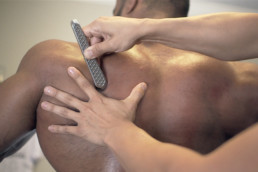
Active Release Techniques may help the body...
Improve Motion
Quickly improves range of motion and flexibility of joint and soft tissue structures.
Drug-Free Pain Relief
Decreases pain intensity and pain pressure thresholds quickly and effectively.
Restore Function
Releases fascial restrictions, entrapped nerves, vasculature and soft tissue dysfunction.
What is Graston Technique?
Graston Technique is a soft tissue technique designed to break cross-fiber scar tissue links, splay these fibers and increase fascial mobility. When clinically indicated, GT is also used to re-initiate the inflammatory process by introducing small amounts of micro-trauma to the tissue. This results in a fresh new flow of blood, nutrients and fibroblasts to the region to re-stimulate the healing cascade within the fibrotic and dysfunctional tissues.
The patented GT Instruments are used to scan the injured area and assist clinicians to locate and then treat the injured tissue that is causing pain and restricting motion. Our doctors utilize the instruments to supply precise pressure to break up scar tissue, which relieves discomfort and restores normal function. The technique involves the use of six hand held stainless steel instruments specifically designed to detect and effectively treat areas exhibiting soft tissue fibrosis or chronic inflammation. The instruments are shaped to fit the various contours of the body in order to maximize treatment efficacy. This design allows for ease of treatment and maximum tissue penetration specifically in regions of the body which are hard to access with the doctors hands (such as the plantar fascia at the heel). The Graston Technique Instruments, much like a tuning fork, resonate in the doctors’ hands allowing the doctors to isolate adhesions and restrictions, and treat them very precisely. Since the metal surface of the instruments does not compress like the fat pads of the finger, deeper restrictions can be accessed and treated. When explaining the properties of the instruments, the analogy of a stethoscope can be used. Just as a stethoscope amplifies what the human ear can hear, so do the instruments increase significantly what the human hands can feel.
Prior to each and every Graston treatment, a specially designed lubricant is applied to the skin. This lubricant allows the treatment instruments to glide over the skin without causing irritation. Graston Technique® is then administered in multiple directions in order to break up the soft tissue lesion/scar tissue in all fascial planes. As the GT instruments are applied, a “vibratory” sensation is felt through the tool to the doctors’ fingertips. The patient simultaneously experiences a similar sensation while the tool traverses the area being treated.
A groundbreaking approach to soft-tissue treatment.
Physiologic Benefits
Stimulate Healing
Graston treatment is thought to stimulate connective tissue remodeling through resorption of excessive fibrosis, along with inducing repair and regeneration of collagen secondary to fibroblast recruitment. In turn, this will result in the release and breakdown of scar tissue, adhesions, and fascial restrictions. In laboratory studies using a rat model, the use of instruments resulted in increased fibroblast proliferation and collagen repair in cases of enzyme-induced tendinitis. These findings provide initial support for IASTM stimulating connective tissue remodeling.
Increase Range of Motion
The utilization of Graston Technique has been reported to produce a localized inflammatory response, reduce soft-tissue adhesions, and increase range of motion and mobility in those with musculoskeletal disorders. Several studies have demonstrated significant changes in range of motion compared to the control group.
Pain Relief
There is some evidence that demonstrates that Graston Technique / IASTM can reduce pain intensity and pain pressure thresholds post treatment. Several studies have shown improved symptoms of lower back pain, considered to be one of the leading sources of dysfunction among adults.
What Conditions Will Benefit?
Graston Technique is effective for treatment of soft-tissue conditions or MSDs – including tightness, pain, tingling, inflammation, restricted range of motion, muscle ache, and related symptoms.
- Arthritis
- Sports Injuries
- Neck Pain (Cervical Sprain / Strain)
- Back Pain (Lumbar Sprain / Strain)
- Knee Pain (Patellofemoral Disorders)
- Ankle Pain (Achilles Tendinitis)
- Foot Pain (Plantar Fasciitis)
- Shoulder Pain (Rotator Cuff Tendinitis)
- Tennis Elbow (Lateral Epicondylitis)
- Golfer’s Elbow (Medial Epicondylitis)
- Wrist Pain (Carpal Tunnel Syndrome)
- IT Band (Iliotibial Band)
- Repetitive Stress Injuries
- TMJ
- Muscle Strains
- Ligament Sprains
- Shin Splints

Learn More About Graston Technique
What to Expect During Treatment
Treatment sessions last about 15-minutes and many patients experience dramatic reduction in pain and increase in range of motion after their first treatment. Most problems are resolved in five or fewer treatments. Patients are advised they may be sore, bruised or exhibit small red dots over the area treated, called petechiae. If any soreness is felt after the procedure, ice application for 15 to 20 minutes following the treatment may ease the discomfort.
How Many Treatments Are Recommended?
How many sessions a person needs depends on the severity of the health concern. While many people may benefit from a single session, often times more complex conditions may require more frequent treatment.
Read More
Active Release Techniques
Active Release Techniques
Active Release Techniques® is the global leader in non-invasive soft-tissue and nerve treatment, including treatment of strains, sprains, and other musculoskeletal disorders (MSDs). Hands-on, movement-based ART treatment is specifically designed to quickly reduce pain and restore function. Whether you’ve got a minor strain or a complex injury, ART gets you back to work and back to play faster and more effectively than conventional therapy methods.

Active Release Techniques may help the body...
Improve Motion
Quickly improves range of motion and flexibility of joint and soft tissue structures.
Drug-Free Pain Relief
Decreases pain intensity and pain pressure thresholds quickly and effectively.
Restore Function
Release fascial restrictions, entrapped nerves, vasculature and helps correct soft tissue dysfunction.
What is Active Release Techniques?
When you injure muscles, tendons or ligaments, scar tissue forms around the injury. Scar tissue is created from collagen cells found in these soft tissues. New collagen cells are formed in the wake of an injury, but they often aggregate without order, producing scars. Although scar tissue does not disappear quickly naturally, it is not permanent. Your body may use a process called remodeling to loosen and replace these collagen cell adhesions. This process may take weeks, months or years to break up without medical intervention.
Active Release Techniques uses manual manipulation to apply compressive, tensile and shear forces to address myofascial restrictions that could be leading to soft tissue dysfunction. The clinician applies deep tension at the area of dysfunction whilst the patient is instructed to actively move the tissue from a shortened to a lengthened position. By placing the contact point near the lesion and instructing the patient to move in a manner that produces a longitudinal sliding motion of soft tissues, e.g, nerves, ligaments and muscles beneath the contact point, ART is effective at restoring soft tissue dysfunction.
The Gold Standard in soft-tissue care.
Physiologic Benefits
Increase Range of Motion
Research shows that ART treatments can help improve range of motion and mobility in those with musculoskeletal disorders or following injuries (acute trauma) and episodes of chronic pain.
One study published in the Journal of Physical Therapy Science demonstrated significant changes in range of motion compared to the control group. The ART group was found to produce greater improvements overall in several of the markers compared to the control group.
Pain Relief
Several studies demonstrate that Active Release Techniques can reduce pain intensity and pain pressure thresholds post treatment.
One study conducted by the Korean Academy of Physical Therapy Rehabilitation Science found that ART helps lower symptoms of lower back pain, considered to be one of the leading sources of dysfunction among adults.
Reduces Nerve Entrapments
A study published in the Journal of Chiropractic Medicine suggest that Active Release Techniques can be an effective treatment strategy for patients with carpal tunnel syndrome, which results in limited hand mobility and often swelling or pain due to nerve compression. Following treatment, patients reported significant improvements in symptom severity and showed increases in functional status scores compared to the start of the study.
Mitochondrial Support
HBOT allows mitochondria, the batteries of our cells, to generate adenosine triphosphate, or ATP. ATP is the chemical that stores and releases energy necessary for many cellular processes and is the main energy source for our body. When you have experienced cellular damage and oxygen-carrying capacity is threatened, your body is in jeopardy of not creating enough ATP. By providing high levels of oxygen, HBOT helps optimize cellular energy production.
Neovascularization
Hyperbaric oxygen therapy stimulates the growth of new blood vessels in the body, which increases circulation, allowing revitalized tissue to thrive even after the treatment protocol has been completed.
Stem Cell Mobilization
During treatment, HBOT has the power to increase stem cells in circulation eight-fold. These stems cells already exist in the body and have the unique ability to differentiate into any type of tissue, making them a valuable tool for regeneration and healing.
What Conditions Will Benefit?
ART treatment is effective against signs and symptoms of muscle and nerve dysfunction – sometimes referred to as soft-tissue conditions or MSDs – including tightness, pain, tingling, inflammation, restricted range of motion, muscle ache, and related symptoms.
- Arthritis
- Sports Injuries
- Neck Pain (Cervical Sprain / Strain)
- Back Pain (Lumbar Sprain / Strain)
- Knee Pain (Patellofemoral Disorders)
- Ankle Pain (Achilles Tendinitis)
- Foot Pain (Plantar Fasciitis)
- Shoulder Pain (Rotator Cuff Tendinitis)
- Tennis Elbow (Lateral Epicondylitis)
- Golfer’s Elbow (Medial Epicondylitis)
- Wrist Pain (Carpal Tunnel Syndrome)
- IT Band (Iliotibial Band)
- Repetitive Stress Injuries
- TMJ
- Muscle Strains
- Ligament Sprains
- Shin Splints

Learn More About Active Release Techniques
What to Expect During Treatment
Treatment sessions last about 15-minutes and many patients experience dramatic reduction in pain and increase in range of motion after their first treatment. Most problems are resolved in five or fewer treatments. Meaning you spend less time in waiting rooms and doctor’s offices, and more time living your life.
How Many Treatments Are Recommended?
How many sessions a person needs depends on the severity of the health concern. While many people may benefit from a single session, often times more complex conditions may require more frequent treatment.
Read More
Deep Tissue Laser Therapy
Deep Tissue Laser Therapy
Deep Tissue Laser Therapy accelerates your body’s own natural healing process through photo-bio-stimulation. Our 40-watt Liteforce Therapy Laser is effective in treating chronic conditions, acute conditions and post surgical pain.
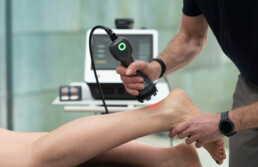
Hyperbaric Oxygen Therapy may help the body...
Accelerate Healing
Stimulate soft tissue & bone repair, nerve regeneration, & increased cellular metabolism.
Anti-Inflammation
Increase microcirculation, vasodilation and activation of the lymphatic drainage system.
Drug Free Pain Relief
Promotes release of pain killing chemicals such as endorphins and enkephalins from the brain and adrenal gland.
What is Deep Tissue Laser Therapy?
Laser therapy is a medical treatment that uses focused light to stimulate a process called photobiomodulation (PBM). During PBM, photons enter the tissue and trigger a biological cascade of events that leads to an increase in cellular metabolism, which can decrease pain and inflammation and accelerate the healing process. Laser therapy is used to treat acute and chronic conditions as well as post-activity recovery. When treating acute conditions with laser therapy, it is particularly effective when it is administered as soon as possible following injury. With chronic conditions, laser therapy is used most often to help combat persistent pain and inflammation. To aid in post-activity recovery, LightForce Lasers are used by over 250 pro, college, and Olympic sports teams across the United States and many parts of Europe and East Asia.
The 40W LightForce® XLi is the most powerful laser available!
Physiologic Benefits
Accelerated Tissue Repair And Cell Growth
Accelerate cellular reproduction and growth. Unlike other treatment modalities, powerful Class 4 Laser Therapy can penetrate superficial tissues and deliver healing energy to deeper structures and articular surfaces. Cells of cartilage, bone, tendons, ligaments and muscles are repaired faster as a result of exposure to high powered NIR or Near InfraRed Laser photons.
Reduced Fibrous Tissue Formation
Class 4 Laser therapy reduces the formation of scar tissue following tissue damage and acute and chronic inflammatory processes. This point is paramount because fibrous (scar) tissue is less elastic, has poorer circulation, is more pain sensitive, weaker, and much more prone to re-injury and frequent exacerbation.
Anti-Inflammation
Laser light therapy has an anti-inflammatory effect, as it causes vasodilation and activation of the lymphatic drainage system. As a result, there is a reduction in swelling caused by biomechanical stress, trauma, overuse, or systemic conditions. Being able to easy support the movement of lymph support faster healing.
Analgesia
Laser therapy has a multifaceted beneficial effect on pain relief. It activates production of high levels of pain killing chemicals such as endorphins and enkephalins from the brain and adrenal gland. Additionally it initiates the suppression of nerve signal transmission over unmyelinated c-fibers that transmit pain to the brain. This means that a greater amount of stimuli is required to create an action potential within the nerve to signal pain.
Improved Vascular Activity
Laser light will significantly increase the formation of new capillaries (angiogenesis) in damaged tissue that will speed up the healing process. Additionally, it has been noted in the literature that microcirculation increases secondary to vasodilation during laser treatment.
Stimulates Trigger Points and Acupuncture Points
Stimulates muscle trigger points to help release contracted tissues, helps restoration of muscular tonus and balance. Can also be used to quickly and easily treat acupoints and trace meridians to quickly open up blocked energy flow within numerous body systems from the macro to the micro-systems.
What Conditions Will Benefit?
Deep Tissue Laser Therapy has been clinically proven as an effective treatment for a vast array of both acute and chronic conditions.
- Arthritis
- Sports Injuries
- Neck Pain (Cervical Sprain / Strain)
- Back Pain (Lumbar Sprain / Strain)
- Knee Pain (Patellofemoral Disorders)
- Ankle Pain (Achilles Tendinitis)
- Foot Pain (Plantar Fasciitis)
- Shoulder Pain (Rotator Cuff Tendinitis)
- Tennis Elbow (Lateral Epicondylitis)
- Golfer’s Elbow (Medial Epicondylitis)
- Wrist Pain (Carpal Tunnel Syndrome)
- IT Band (Iliotibial Band)
- Repetitive Stress Injuries
- TMJ
- Muscle Strains
- Ligament Sprains
- Shin Splints
- Rheumatoid Arthritis
- Herpes Zoster (Shingles)
- Diabetic Neuropathy
- Diabetic Foot Ulcers
- Trigeminal Neuralgia
- Burns
- Deep Edema / Congestion

Learn More About Deep Tissue Laser Therapy
What to Expect During Treatment
Laser therapy treatments must be administered directly to skin, as laser light cannot penetrate through layers of clothing. You will feel a soothing warmth as the therapy is administered. Many patients receiving LightForce® Therapy Laser treatments report enjoying the experience, especially when a massage-ball treatment head is used to deliver what is often referred to as a “laser massage.”
Patients receiving treatments with higher-power lasers also frequently report a rapid decrease in pain. For someone suffering from chronic pain, this effect can be particularly pronounced. Laser therapy for pain can be a viable treatment.
With LightForce® lasers, treatments are quick usually 3-10 minutes depending on the size, depth, and acuteness of the condition being treated. High-power lasers are able to deliver a lot of energy in a small amount of time, allowing therapeutic dosages to be achieved quickly. For patients and clinicians with packed schedules, fast and effective treatments are a must.
How Many Treatments Are Recommended?
How many treatments a person needs depends on the severity of the health condition. While many people may benefit from a single session, often times more complex conditions may require more frequent treatment. Most clinicians will encourage their patients to receive 2-3 treatments per week as the therapy is initiated. There is a well-documented support that the benefits of laser therapy are cumulative, suggesting that plans for incorporating laser as part of a patient’s plan of care should involve early, frequent treatments that may be administered less frequently as the symptoms resolve. Your doctor will develop a treatment plan that is optimal for your condition.
Hyperbaric Oxygen Therapy
Mild Hyperbaric Oxygen Therapy
Hyperbaric Oxygen Therapy has been shown the be one of the most effective and safest therapies to saturate the body with life sustaining and rejuvenating oxygen. It helps stimulate your immune system and works to alleviate inflammation and pain, improving healing mechanisms in your body as a result. Hyperbaric Oxygen Therapy is FDA-approved for 14 different conditions and has various applications for off-label conditions.
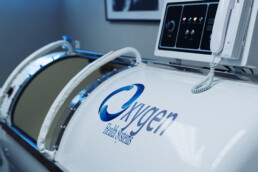
Hyperbaric Oxygen Therapy may help the body...
Accelerate Healing
Decreases inflammation, enhances immune function, blood flow, collagen production, and stem cell migration.
Enhance Brain Function
Improve cerebral blood flow and brain microstructure, leading to improved cognitive functions, sleep, and gait.
Optimize Recovery
Faster removal of lactic acid from muscle tissue, reduces delayed onset muscle soreness, enhances tissue regeneration.
What is Hyperbaric Oxygen Therapy?
Hyperbaric oxygen therapy has been shown to accelerate healing in the brain and throughout the rest of the body by encouraging blood flow and oxygen circulation in damaged areas. Hyperbaric oxygen therapy involves breathing higher concentrations of oxygen while pressurizing the body to pressures greater than normal 1 ATA (the pressure at sea level). Instead of using high ATA (3 – 5 ATA), which can potentially have various side effects, it has been shown in past 20 years that using low ATA (1.3 – 1.6 ATA) can produce similar positive health benefits with almost no side effects. Our clinic uses the highest quality 1.6 ATA mild HBOT chamber available.
The process is achieved inside a specialized chamber in which the patient comfortably breathes higher concentrations of oxygen while the pressure inside the chamber is gradually increased. Based on laws of physics, breathing oxygen under pressure allows oxygen to be dissolved into the plasma portion of the blood. Under normal conditions, plasma does not carry oxygen, that is left to the red blood cell and hemoglobin. Dissolving oxygen into plasma allows it to carry oxygen at least four times further into the body’s tissues which results in a much higher concentration of oxygen within the body – as much as 1,200% higher!
But why would you need or want to increase the concentration of oxygen in your body? Under normal conditions, the air we breathe contains a mixture of gases, of which only about 21% is oxygen. This is generally sufficient for the body’s basic functions in those with normal lungs. However, elevating the oxygen level in the body creates a whole cascade of benefits both in the immediate short term as well as more long term (if done enough times). It is this cascade of benefits that enhances and accelerates the body’s ability to repair itself, generate energy, and create an environment in which inflammation is suppressed and regenerative healing is promoted.
"Mental clarity and focus that I haven't felt in decades."
Physiologic Benefits
Hyperoxygenation
As discussed above, HBOT increases the amount of oxygen carried into the blood stream, enabling more oxygen to dissolve deep into the body’s tissues, including the lymphatics and the cerebrospinal fluid surrounding the brain and spinal cord. This reverses hypoxia (areas of the body that are low in oxygen) helping to oxygenate cells and tissue that are at risk of dying (such as tissue damaged during surgery, or from loss of blood supply) or that are in a quiescent or non-functioning state.
Anti-Inflammation
In the short term HBOT downregulates inflammatory pathways and constricts blood vessels to allow less leakage of fluid thus decreasing swelling. In the long term HBOT has epigenetic effects turning off the genes responsible for inflammation. Inflammation is a key factor in why our body’s degrade with time. Reducing inflammation and swelling, strengthens the immune system and enhances mitochondrial function.
AntiMicrobial Effect
Hyperbaric oxygen therapy improves the immune system by weakening infection-causing bacteria. It also increases the body’s natural antioxidants and free radical scavengers, which increases the ability to fight disease and infection. It can also synergize with certain antibiotics improving their efficacy.
Mitochondrial Support
HBOT allows mitochondria, the batteries of our cells, to generate adenosine triphosphate, or ATP. ATP is the chemical that stores and releases energy necessary for many cellular processes and is the main energy source for our body. When you have experienced cellular damage and oxygen-carrying capacity is threatened, your body is in jeopardy of not creating enough ATP. By providing high levels of oxygen, HBOT helps optimize cellular energy production.
Neovascularization
Hyperbaric oxygen therapy stimulates the growth of new blood vessels in the body, which increases circulation, allowing revitalized tissue to thrive even after the treatment protocol has been completed.
Stem Cell Mobilization
During treatment, HBOT has the power to increase stem cells in circulation eight-fold. These stems cells already exist in the body and have the unique ability to differentiate into any type of tissue, making them a valuable tool for regeneration and healing.
What Conditions Will Benefit?
Hyperbaric oxygen therapy can treat a wide variety of illnesses, injuries, and other conditions. However, there are only 14 indications approved by the FDA. Although the others are not yet approved, there is extensive research citing HBOT’s ability to heal other indications.
FDA Approved Conditions
These conditions, which can be referred to as “on-label”, are approved by the FDA.
- Air or Gas Embolism
- Carbon Monoxide Poisoning
- Central Retinal Artery Occlusion
- Chronic Refractory Osteomyelitis
- Crush Injury & Other Acute Traumatic Ischemias
- Decompression Sickness
- Diabetic Lower Extremity Wounds
- Failed Skin Grafts & Flaps
- Gas Gangrene
- Necrotizing Soft Tissue Infections
- Radiation Tissue Damage
- Severe Anemia
- Sudden Sensorineural Hearing Loss
- Thermal Burns (severe)
- Intracranial Abscess
Off-Label Conditions
These conditions, which can be referred to as “off-label”, have not yet been approved by the FDA.
- Anoxic Brain Injury
- Arthritis
- Cancer (Treatment Synergy)
- Cerebral Palsy
- Chronic Fatigue Syndrome
- Chronic Pain
- Complex Regional Pain Syndrome
- Concussion & Traumatic Brain Injury
- Crohn’s Disease
- Fibromyalgia
- Inflammatory Bowel Disease
- Interstitial Cystitis
- Lyme Disease
- Migraine/Headache
- Multiple Sclerosis
- Spinal Cord Injuries
- Sports Injuries
- Stroke
- Surgery Preparation & Recovery
- Ulcerative Colitis

Learn More About Hyperbaric Oxygen Therapy
What to Expect During Treatment
Hyperbaric oxygen therapy is simple – just sit back, relax, and breathe normally. Prior to your first session you will first have a consultation with one of our doctors. This consult is to evaluate you for HBOT, confirm there are no contraindications, and establish a protocol most appropriate for your condition(s) to meet your health goals.
During this time, your doctor will also explain how the science behind hyperbaric oxygen therapy works to help the body, and receive an orientation on what is needed before you start treatments, as well as the daily process of preparing for each session.
At the beginning of each session, a technician will check your vitals and review a safety checklist, affirming you have removed all jewelry, watches, and electronic devices, and are free of lotions and perfumes. They will also provide you a 100% cotton gown and blanket for a safe and comfortable experience.
During the entire treatment, a technician will be present by the chamber to guide you, particularly while you descend to your prescribed depth, where you may experience an ear-popping sensation (like when flying on any airplane), as well as attend to any needs or questions you have during your session. Finally, at the end of your session, the technician will again take your vitals.
How Many Treatments Are Recommended?
How many sessions a person needs depends on the severity of the health concern. While many people may benefit from a single session, often times more complex conditions may require more frequent treatment.
1-5 Sessions
Improve cellular energy, decrease inflammation, and initiate tissues repair and regeneration.
5-10 Sessions
Typically used for acute injuries with soft tissue damage and pain.
10-20 Sessions
For more serious acute injuries or chronic injuries.
20-40 Sessions
Commonly used for major tissue damage when new tissue is required and for various chronic illnesses and brain conditions.